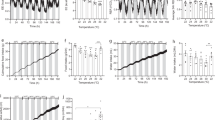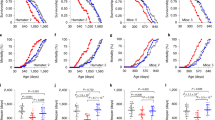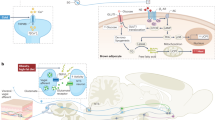Abstract
The genetically obese (ob/ob) mouse has been extensively studied as a model of early-onset obesity. These mice are characterized by a wide variety of endocrine and metabolic defects including hyperglycaemia, hyperinsulinaemia with insulin resistance, hyperlipidaemia and hyperphagia1,2. The marked obesity of this mutant cannot be attributed to overeating because it remains fat even when fed the same amount of food as its lean littermate3,4. The earliest indicators of the ob/ob genotype, low metabolic rate and low body temperature, are detectable 7–10 days after birth5,6. Hypothermia might, therefore, be a prime contributor to the development of obesity because a greater percentage of the diet will be diverted to fat rather than ‘wasted’ for thermogenesis7–9. As the obese mouse exhibits hypothermia over a wide range of ambient temperatures, it has been suggested that their set-point for body temperature regulation is lower than that of the lean mouse10. If this is the case the obese mouse should maintain a subnormal body temperature when required to work for exogenous heat in a cold environment. We now report that the set-point is unchanged in the obese mouse because it behaviourally defends a body temperature equivalent to that of the lean mouse during cold exposure.
This is a preview of subscription content, access via your institution
Access options
Subscribe to this journal
Receive 51 print issues and online access
$199.00 per year
only $3.90 per issue
Buy this article
- Purchase on Springer Link
- Instant access to full article PDF
Prices may be subject to local taxes which are calculated during checkout
Similar content being viewed by others
References
Bray, G. A. & York, D. A. Physiol. Rev. 51, 598–646 (1971).
Bray, G. A. & York, D. A. Physiol. Rev. 59, 719–809 (1979).
Dubuc, P. U. Am. J. Physiol. 230, 1474–1479 (1976).
Thurlby, P. L. & Trayhurn, P. Br. J. Nutr. 42, 377–385 (1979).
Boissonneault, G. A., Hornshuh, M. J., Simons, J. W., Romsos, D. R. & Leveille, G. A. Proc. Soc. exp. Biol. Med. 157, 402–406 (1978).
Thurlby, P. L. & Trayhurn, P. Br. J. Nutr. 39, 397–402 (1978).
Kaplan, M. L. & Leveille, G. A. Proc. Soc. exp. Biol. Med. 143, 925–928 (1973).
Kaplan, M. L. & Leveille, G. A. Am. J. Physiol. 227, 912–915 (1974).
Trayhurn, P., Thurlby, P. L. & James, W. P.T. Nature 266, 60–62 (1977).
Trayhurn, P. & James, W. P. T. Pflügers Arch. ges. Physiol. 373, 189–193 (1978).
Clark, L. D. & Gray, P. E. Biol. Psychiat. 4, 247–250 (1972).
Ohtake, M., Bray, G. A. & Azukizawa, M. Am. J. Physiol. 233, R110–115 (1977).
York, D. A., Otto, W. & Taylor, T. G. Comp. Biochem. Physiol. 59B, 59–65 (1978).
van der Kroon, P. H. W. & Speijers, G. J. A. Metabolism 33, 1–3 (1979).
Thenen, S. W. & Carr, R. H. J. Nutr. 110, 189–199 (1980).
Kaplan, M. L. & Leveille, G. A. Am. J. Physiol. 240, E101–107 (1981).
Macdonald, I. A. & Stock, M. J. Nutr. Metab. 23, 250–255 (1979).
Hogan, S. & Himms-Hagen, J. Am. J. Physiol. 239, E301–309 (1980).
Thurlby, P. L. & Trayhurn, P. Pflügers Arch. ges. Physiol. 385, 193–201 (1980).
Romsos, D. R. Fedn Proc. 40, 2524–2529 (1981).
Author information
Authors and Affiliations
Rights and permissions
About this article
Cite this article
Carlisle, H., Dubuc, P. Unchanged thermoregulatory set-point in the obese mouse. Nature 297, 678–679 (1982). https://doi.org/10.1038/297678a0
Received:
Accepted:
Issue Date:
DOI: https://doi.org/10.1038/297678a0
Comments
By submitting a comment you agree to abide by our Terms and Community Guidelines. If you find something abusive or that does not comply with our terms or guidelines please flag it as inappropriate.



